Xiaodan Liang
Knowledge-Routed Visual Question Reasoning: Challenges for Deep Representation Embedding
Dec 14, 2020
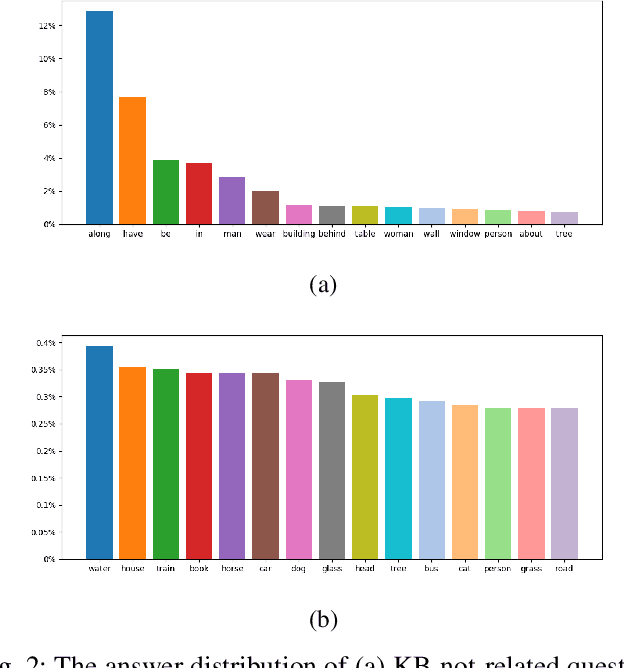
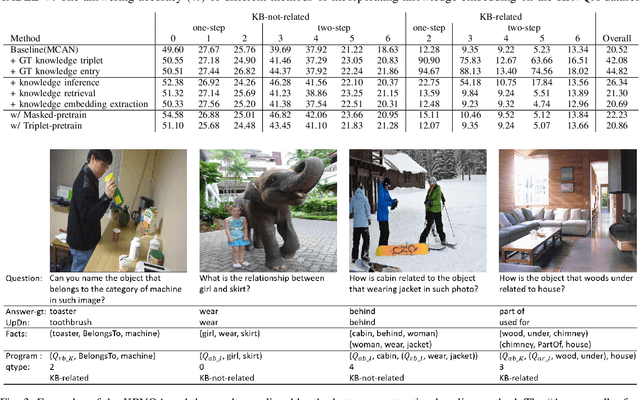
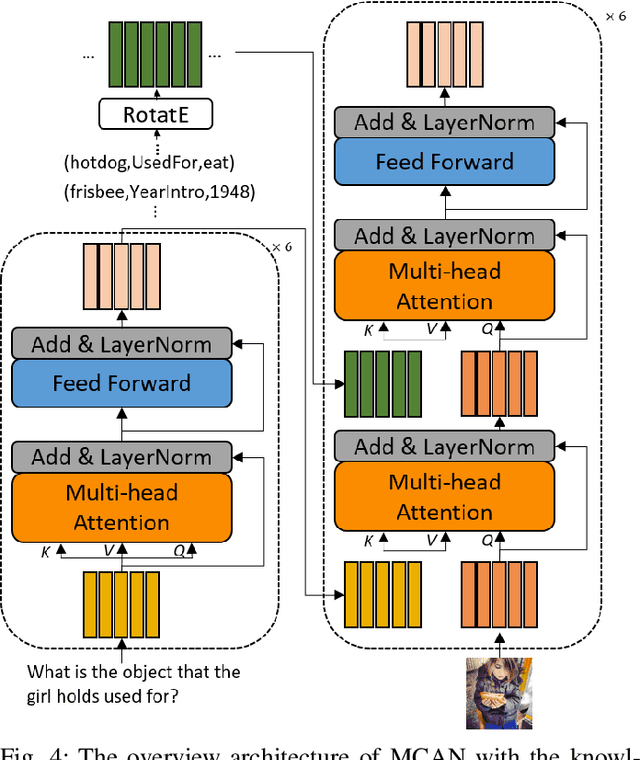
Abstract:Though beneficial for encouraging the Visual Question Answering (VQA) models to discover the underlying knowledge by exploiting the input-output correlation beyond image and text contexts, the existing knowledge VQA datasets are mostly annotated in a crowdsource way, e.g., collecting questions and external reasons from different users via the internet. In addition to the challenge of knowledge reasoning, how to deal with the annotator bias also remains unsolved, which often leads to superficial over-fitted correlations between questions and answers. To address this issue, we propose a novel dataset named Knowledge-Routed Visual Question Reasoning for VQA model evaluation. Considering that a desirable VQA model should correctly perceive the image context, understand the question, and incorporate its learned knowledge, our proposed dataset aims to cutoff the shortcut learning exploited by the current deep embedding models and push the research boundary of the knowledge-based visual question reasoning. Specifically, we generate the question-answer pair based on both the Visual Genome scene graph and an external knowledge base with controlled programs to disentangle the knowledge from other biases. The programs can select one or two triplets from the scene graph or knowledge base to push multi-step reasoning, avoid answer ambiguity, and balanced the answer distribution. In contrast to the existing VQA datasets, we further imply the following two major constraints on the programs to incorporate knowledge reasoning: i) multiple knowledge triplets can be related to the question, but only one knowledge relates to the image object. This can enforce the VQA model to correctly perceive the image instead of guessing the knowledge based on the given question solely; ii) all questions are based on different knowledge, but the candidate answers are the same for both the training and test sets.
Ada-Segment: Automated Multi-loss Adaptation for Panoptic Segmentation
Dec 07, 2020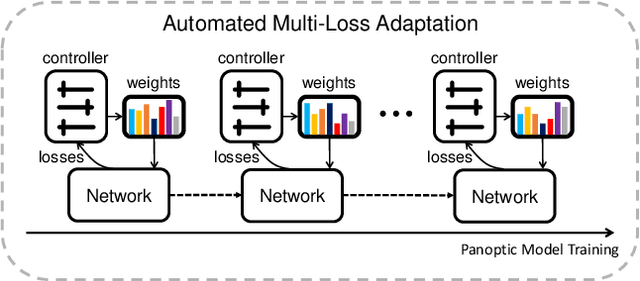
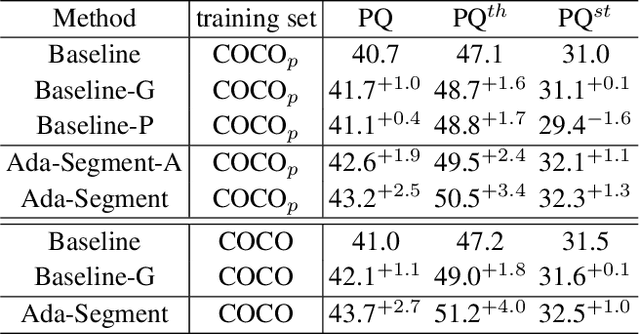


Abstract:Panoptic segmentation that unifies instance segmentation and semantic segmentation has recently attracted increasing attention. While most existing methods focus on designing novel architectures, we steer toward a different perspective: performing automated multi-loss adaptation (named Ada-Segment) on the fly to flexibly adjust multiple training losses over the course of training using a controller trained to capture the learning dynamics. This offers a few advantages: it bypasses manual tuning of the sensitive loss combination, a decisive factor for panoptic segmentation; it allows to explicitly model the learning dynamics, and reconcile the learning of multiple objectives (up to ten in our experiments); with an end-to-end architecture, it generalizes to different datasets without the need of re-tuning hyperparameters or re-adjusting the training process laboriously. Our Ada-Segment brings 2.7% panoptic quality (PQ) improvement on COCO val split from the vanilla baseline, achieving the state-of-the-art 48.5% PQ on COCO test-dev split and 32.9% PQ on ADE20K dataset. The extensive ablation studies reveal the ever-changing dynamics throughout the training process, necessitating the incorporation of an automated and adaptive learning strategy as presented in this paper.
Continuous Transition: Improving Sample Efficiency for Continuous Control Problems via MixUp
Nov 30, 2020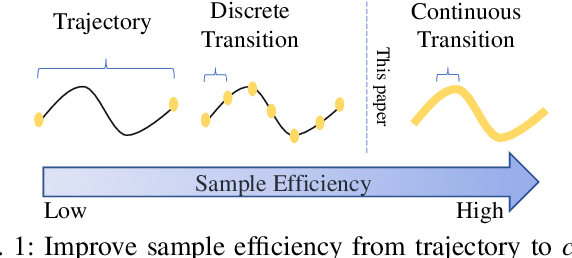

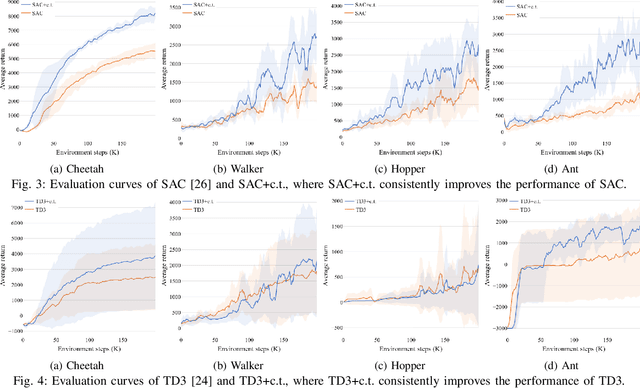

Abstract:Although deep reinforcement learning~(RL) has been successfully applied to a variety of robotic control tasks, it's still challenging to apply it to real-world tasks, due to the poor sample efficiency. Attempting to overcome this shortcoming, several works focus on reusing the collected trajectory data during the training by decomposing them into a set of policy-irrelevant discrete transitions. However, their improvements are somewhat marginal since i) the amount of the transitions is usually small, and ii) the value assignment only happens in the joint states. To address these issues, this paper introduces a concise yet powerful method to construct \textit{Continuous Transition}, which exploits the trajectory information by exploiting the potential transitions along the trajectory. Specifically, we propose to synthesize new transitions for training by linearly interpolating the conjunctive transitions. To keep the constructed transitions authentic, we also develop a discriminator to guide the construction process automatically. Extensive experiments demonstrate that our proposed method achieves a significant improvement in sample efficiency on various complex continuous robotic control problems in MuJoCo and outperforms the advanced model-based / model-free RL methods.
Towards Robust Medical Image Segmentation on Small-Scale Data with Incomplete Labels
Nov 28, 2020
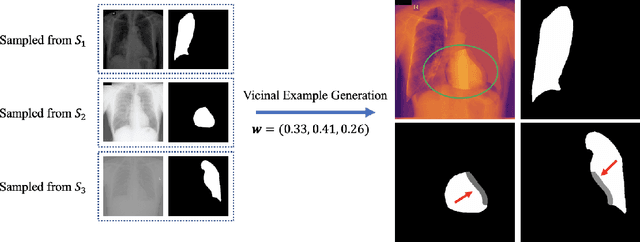
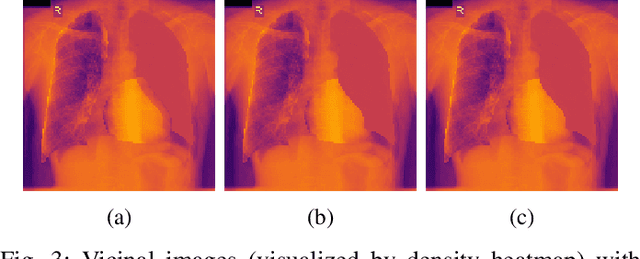

Abstract:The data-driven nature of deep learning models for semantic segmentation requires a large number of pixel-level annotations. However, large-scale and fully labeled medical datasets are often unavailable for practical tasks. Recently, partially supervised methods have been proposed to utilize images with incomplete labels to mitigate the data scarcity problem in the medical domain. As an emerging research area, the breakthroughs made by existing methods rely on either large-scale data or complex model design, which makes them 1) less practical for certain real-life tasks and 2) less robust for small-scale data. It is time to step back and think about the robustness of partially supervised methods and how to maximally utilize small-scale and partially labeled data for medical image segmentation tasks. To bridge the methodological gaps in label-efficient deep learning with partial supervision, we propose RAMP, a simple yet efficient data augmentation framework for partially supervised medical image segmentation by exploiting the assumption that patients share anatomical similarities. We systematically evaluate RAMP and the previous methods in various controlled multi-structure segmentation tasks. Compared to the mainstream approaches, RAMP consistently improves the performance of traditional segmentation networks on small-scale partially labeled data and utilize additional image-wise weak annotations.
Auto-Panoptic: Cooperative Multi-Component Architecture Search for Panoptic Segmentation
Oct 30, 2020



Abstract:Panoptic segmentation is posed as a new popular test-bed for the state-of-the-art holistic scene understanding methods with the requirement of simultaneously segmenting both foreground things and background stuff. The state-of-the-art panoptic segmentation network exhibits high structural complexity in different network components, i.e. backbone, proposal-based foreground branch, segmentation-based background branch, and feature fusion module across branches, which heavily relies on expert knowledge and tedious trials. In this work, we propose an efficient, cooperative and highly automated framework to simultaneously search for all main components including backbone, segmentation branches, and feature fusion module in a unified panoptic segmentation pipeline based on the prevailing one-shot Network Architecture Search (NAS) paradigm. Notably, we extend the common single-task NAS into the multi-component scenario by taking the advantage of the newly proposed intra-modular search space and problem-oriented inter-modular search space, which helps us to obtain an optimal network architecture that not only performs well in both instance segmentation and semantic segmentation tasks but also be aware of the reciprocal relations between foreground things and background stuff classes. To relieve the vast computation burden incurred by applying NAS to complicated network architectures, we present a novel path-priority greedy search policy to find a robust, transferrable architecture with significantly reduced searching overhead. Our searched architecture, namely Auto-Panoptic, achieves the new state-of-the-art on the challenging COCO and ADE20K benchmarks. Moreover, extensive experiments are conducted to demonstrate the effectiveness of path-priority policy and transferability of Auto-Panoptic across different datasets. Codes and models are available at: https://github.com/Jacobew/AutoPanoptic.
Towards Interpretable Natural Language Understanding with Explanations as Latent Variables
Oct 24, 2020



Abstract:Recently generating natural language explanations has shown very promising results in not only offering interpretable explanations but also providing additional information and supervision for prediction. However, existing approaches usually require a large set of human annotated explanations for training while collecting a large set of explanations is not only time consuming but also expensive. In this paper, we develop a general framework for interpretable natural language understanding that requires only a small set of human annotated explanations for training. Our framework treats natural language explanations as latent variables that model the underlying reasoning process of a neural model. We develop a variational EM framework for optimization where an explanation generation module and an explanation-augmented prediction module are alternatively optimized and mutually enhance each other. Moreover, we further propose an explanation-based self-training method under this framework for semi-supervised learning. It alternates between assigning pseudo-labels to unlabeled data and generating new explanations to iteratively improve each other. Experiments on two natural language understanding tasks demonstrate that our framework can not only make effective predictions in both supervised and semi-supervised settings, but also generate good natural language explanation.
Iterative Graph Self-Distillation
Oct 23, 2020



Abstract:How to discriminatively vectorize graphs is a fundamental challenge that attracts increasing attentions in recent years. Inspired by the recent success of unsupervised contrastive learning, we aim to learn graph-level representation in an unsupervised manner. Specifically, we propose a novel unsupervised graph learning paradigm called Iterative Graph Self-Distillation (IGSD) which iteratively performs the teacher-student distillation with graph augmentations. Different from conventional knowledge distillation, IGSD constructs the teacher with an exponential moving average of the student model and distills the knowledge of itself. The intuition behind IGSD is to predict the teacher network representation of the graph pairs under different augmented views. As a natural extension, we also apply IGSD to semi-supervised scenarios by jointly regularizing the network with both supervised and unsupervised contrastive loss. Finally, we show that finetuning the IGSD-trained models with self-training can further improve the graph representation power. Empirically, we achieve significant and consistent performance gain on various graph datasets in both unsupervised and semi-supervised settings, which well validates the superiority of IGSD.
MedDG: A Large-scale Medical Consultation Dataset for Building Medical Dialogue System
Oct 15, 2020

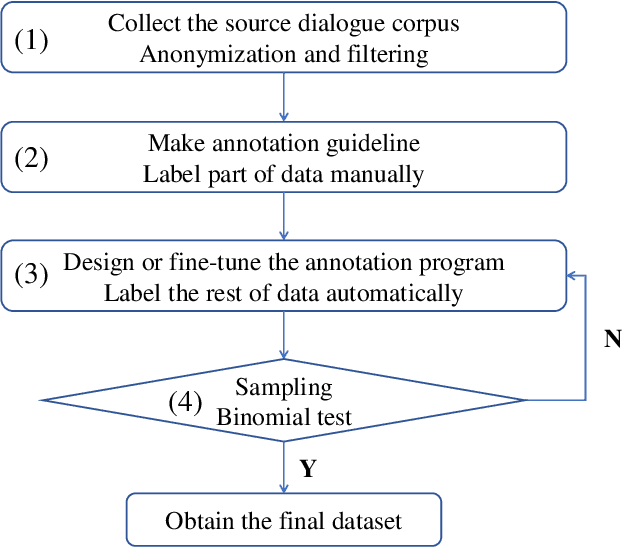
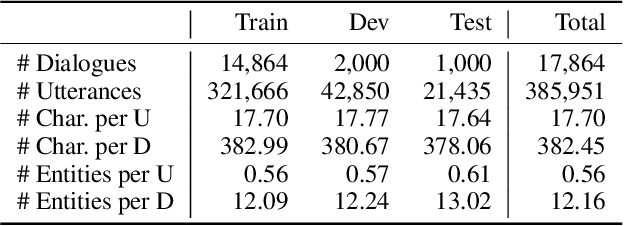
Abstract:Developing conversational agents to interact with patients and provide primary clinical advice has attracted increasing attention due to its huge application potential, especially in the time of COVID-19 Pandemic. However, the training of end-to-end neural-based medical dialogue system is restricted by an insufficient quantity of medical dialogue corpus. In this work, we make the first attempt to build and release a large-scale high-quality Medical Dialogue dataset related to 12 types of common Gastrointestinal diseases named MedDG, with more than 17K conversations collected from the online health consultation community. Five different categories of entities, including diseases, symptoms, attributes, tests, and medicines, are annotated in each conversation of MedDG as additional labels. To push forward the future research on building expert-sensitive medical dialogue system, we proposes two kinds of medical dialogue tasks based on MedDG dataset. One is the next entity prediction and the other is the doctor response generation. To acquire a clear comprehension on these two medical dialogue tasks, we implement several state-of-the-art benchmarks, as well as design two dialogue models with a further consideration on the predicted entities. Experimental results show that the pre-train language models and other baselines struggle on both tasks with poor performance in our dataset, and the response quality can be enhanced with the help of auxiliary entity information. From human evaluation, the simple retrieval model outperforms several state-of-the-art generative models, indicating that there still remains a large room for improvement on generating medically meaningful responses.
Semantically-Aligned Universal Tree-Structured Solver for Math Word Problems
Oct 14, 2020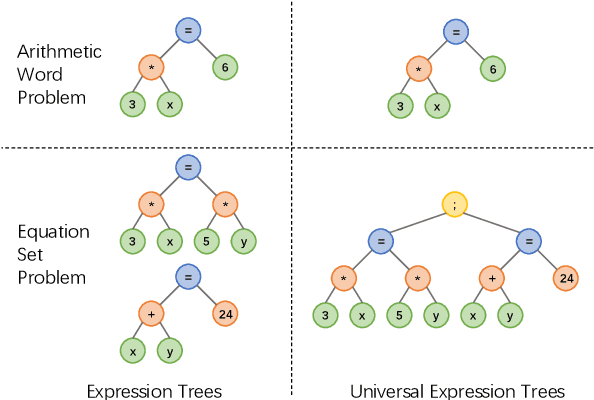

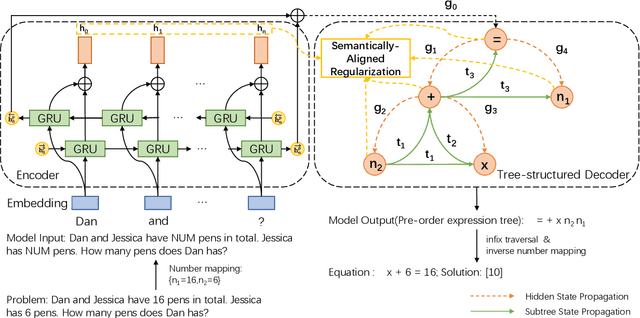

Abstract:A practical automatic textual math word problems (MWPs) solver should be able to solve various textual MWPs while most existing works only focused on one-unknown linear MWPs. Herein, we propose a simple but efficient method called Universal Expression Tree (UET) to make the first attempt to represent the equations of various MWPs uniformly. Then a semantically-aligned universal tree-structured solver (SAU-Solver) based on an encoder-decoder framework is proposed to resolve multiple types of MWPs in a unified model, benefiting from our UET representation. Our SAU-Solver generates a universal expression tree explicitly by deciding which symbol to generate according to the generated symbols' semantic meanings like human solving MWPs. Besides, our SAU-Solver also includes a novel subtree-level semanticallyaligned regularization to further enforce the semantic constraints and rationality of the generated expression tree by aligning with the contextual information. Finally, to validate the universality of our solver and extend the research boundary of MWPs, we introduce a new challenging Hybrid Math Word Problems dataset (HMWP), consisting of three types of MWPs. Experimental results on several MWPs datasets show that our model can solve universal types of MWPs and outperforms several state-of-the-art models.
GRADE: Automatic Graph-Enhanced Coherence Metric for Evaluating Open-Domain Dialogue Systems
Oct 08, 2020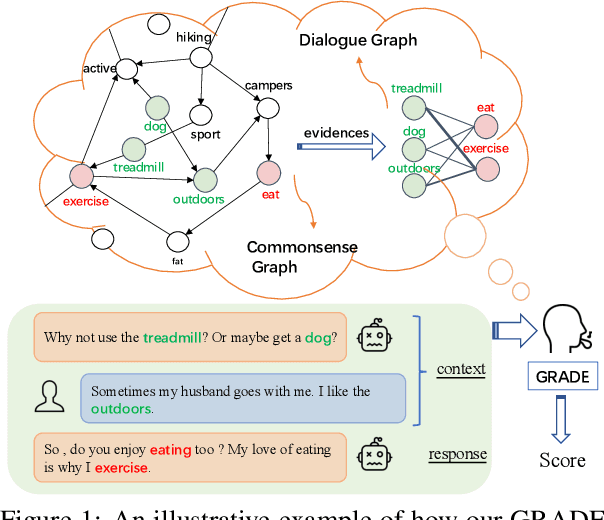


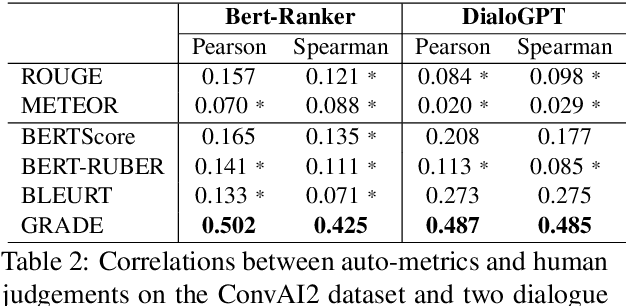
Abstract:Automatically evaluating dialogue coherence is a challenging but high-demand ability for developing high-quality open-domain dialogue systems. However, current evaluation metrics consider only surface features or utterance-level semantics, without explicitly considering the fine-grained topic transition dynamics of dialogue flows. Here, we first consider that the graph structure constituted with topics in a dialogue can accurately depict the underlying communication logic, which is a more natural way to produce persuasive metrics. Capitalized on the topic-level dialogue graph, we propose a new evaluation metric GRADE, which stands for Graph-enhanced Representations for Automatic Dialogue Evaluation. Specifically, GRADE incorporates both coarse-grained utterance-level contextualized representations and fine-grained topic-level graph representations to evaluate dialogue coherence. The graph representations are obtained by reasoning over topic-level dialogue graphs enhanced with the evidence from a commonsense graph, including k-hop neighboring representations and hop-attention weights. Experimental results show that our GRADE significantly outperforms other state-of-the-art metrics on measuring diverse dialogue models in terms of the Pearson and Spearman correlations with human judgements. Besides, we release a new large-scale human evaluation benchmark to facilitate future research on automatic metrics.
 Add to Chrome
Add to Chrome Add to Firefox
Add to Firefox Add to Edge
Add to Edge